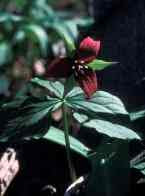As you can imagine, with about 7 billion people on the planet now, we are starting to run out of stuff. In some places, it’s clean water. In others, it’s topsoil. We are reaching the limit of the planet to support us, at least in our extremely consumptive Western lifestyle. Ecologists call this “carrying capacity”. On the graph below, the curvy line shows population over a period of time (the horizontal dimension). Note that the population reaches a certain level and begins to decline. After that it oscillates around a certain number, represented by the horizontal line. That number is the carrying capacity.

If this were a graph of GDP, the upward trends would represent economic growth, and the downward portions would signify recessions. Consider what we’ve been hearing lately: “long, slow recovery”, “double-dip recession”. Seems like recessions hit about every ten to fifteen years, though I may be mistaken. I’m just an ecologist. If we were to graph GDP over the last 200 years, might it look like the graph above?
I didn’t just summon you here for an ecology / economics lesson. By the way, Marston Bates eloquently reminded us they are the same thing. I wanted to share what I’ve been learning since last winter. One of the big resources that will soon limit our potential for growth is oil. Consider for a moment, or a day, how many things in our lives rely on fossil fuels, especially oil. Now the bad news: there is a growing body of evidence that global production of oil is at or near its peak, and will begin to decline in the next few years. We have every expectation that demand will not decline, however, and when demand begins to exceed supply, prices go crazy. Read this again carefully: we’re not about to run out of oil; we’re about to run out of cheap oil. Case in point: the summer of 2008. There are many others if one wishes to dig them up. Yes, we seem to be up against the edge of the Petri dish.
Before you panic, I’d like you to do one or more of several things: visit http://www.transitionculture.org/ and watch the movie “In Transition”, or better yet, read The Transition Handbook by Rob Hopkins. I found section one to be very helpful in explaining the combined threats of Peak Oil and climate change. Section two is an essential reminder that dealing with what we are facing involves a grieving process and recovering from addiction (to oil). The second helpful thing I’ve found is The Archdruid Report, a blog by John Michael Greer. His wisdom and wit are delightful and thought-provoking. A third helpful thing is to attend one or both of the speakers in Traverse City this month.
Another very helpful and hopeful way to deal with the idea of economic, social and environmental upheaval is to remember the ancient wisdom about the healing and nutritive values of plants. Most of our pharmaceuticals are, in some way, derived from oil. They all rely on cheap oil for manufacturing and transportation. One of the solutions or inevitable outcomes seen by those peering into crystal oil drums is that production of just about everything will become much more decentralized, even hyper-local. Enter the beauty of knowing how to use a few herbs.
In my yard, I have plants that will nourish me (dandelion and burdock), treat wounds (yarrow), stabilize blood pressure (dandelion and garlic), reduce the pain of insect stings and bites (plantain), help one’s body use iron well, thus treating anemia (dock), reduce fevers (catnip), help treat colds and flu (elderflower and Echinacea), and many more I’m just beginning to learn. If we can’t get our prescribed pharmaceuticals, let’s go walking in the woods and fields. Those of us who know a few or some of these plants are in a position to help others. We might become the village herbal healers.
There’s a great deal to digest in the news that oil supplies will soon get precarious, or downright undependable. Take your time; go through the stages of panic and grief. After all, we may need to grieve the loss of a culture (also known as suburban sprawl). Talk about this with trusted friends, but they’ll probably look at you like you’re crazy. Get to know your neighbors, too. You might even share a favorite herbal tea with them. Friends, our actions now will determine whether we smack hard up against the wall of resource limitations, or whether we slow gently to a stop on our current path, and have time to steer a course toward a more balanced future.
(Previously published for the Herbal Alliance of Northern Michigan.)



